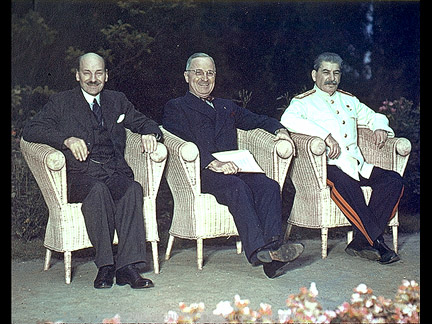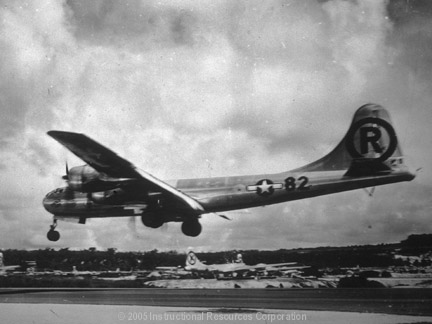Victory at Last
| The "Big Three" meeting at Potsdam | |||
|
|||
| The "Big Three" meeting at Potsdam. IRC. 2005. Discovery Education. 23 January 2010 <http://streaming.discoveryeducation.com/> |
|||
| In July 1945, President Truman met for the first time with the other leaders of the "Big Three" at Potsdam, Germany, to finalize plans for the defeat of Japan. |
While the Allied leaders were resolving important matters at the Potsdam Conference, war continued to rage in the Pacific. Americans had just suffered huge losses at the battles of Iwo Jima and Okinawa, and were in the stages of preparing for a land assault on mainland Japan. In an effort to reduce potentially large casualties numbers from a land invasion, Truman decided instead to drop the atomic bomb; an effort he hoped would force Japan to surrender immediately. After dropping two bombs, Japan agreed to surrender ending World War II once and for all.
 |
Read or view "The Allied Victory" and "The Aftermath of World War II" presentations below and complete the 10.06 Allied Victory Questions. Once finished, submit your work to the 10.06 Allied Victory Questions dropbox. Note: You do not have to review the "The Grand Alliance" or "The Yalta Conference" presentations for this assignment. |
| Enola Gay after dropping first atomic bomb | |||
 |
|
||
 |
|||
 |
|||
 |
|||
| Enola Gay after dropping first atomic bomb. IRC. 2005. Discovery Education. 23 January 2010 <http://streaming.discoveryeducation.com/> |
|||
| The Enola Gay lands at a Mariana Island base after dropping the first atomic bomb on Hiroshima. Truman learned of the bomb and its capabilities while at Potsdam. |
| Hiroshima, Japan, after atomic bomb blast | |||
 |
|
||
 |
|||
 |
|||
 |
|||
| Hiroshima, Japan, after atomic bomb blast.. IRC. 2005. Discovery Education. 23 January 2010 <http://streaming.discoveryeducation.com/> |
|||
| The ruins of Hiroshima, Japan, after the atomic bomb blast on August 6 that killed close to 100,000 people. Concrete structures (such as the Shiumomuna Watch Shop, shown here) up to four-tenths of a mile from the blast were demolished; combustible structures more than two miles away were set on fire. Hiroshima had been virtually undamaged by earlier conventional bombing raids. |
| Occupation zone borders in Germany, 1947 | |||
 |
|
||
 |
|||
 |
|||
 |
|||
| Occupation zone borders in Germany, 1947. Image courtesy of Wikipedia user 52 Pickup. Creative Commons Attribution-Share Alike 2.5 Generic |
|||
| During the Potsdam conference, the Allied leaders divided Germany into four zones of occupation, with each major Allied power controlling a zone. Notice that the capital city of Berlin was also divided and is fully inside of the Soviet sector. (Click here for a larger version) |



